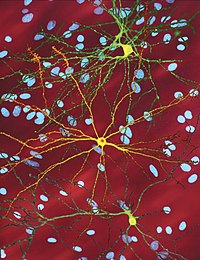
Software development for quantitative analysis of brain amyloid PET
Sign Up to like & getrecommendations! Published in 2022 at "Brain and Behavior"
DOI: 10.1002/brb3.2499
Abstract: Centiloid (CL) scaling has become a standard quantitative measure in amyloid PET because it allows the direct comparison of results across sites, even when different analytical methods or PET tracers are used. read more here.
Keywords: brain; development quantitative; analysis brain; software development ... See more keywords

Amyloid‐β PET in Alzheimer's disease: A systematic review and Bayesian meta‐analysis
Sign Up to like & getrecommendations! Published in 2022 at "Brain and Behavior"
DOI: 10.1002/brb3.2850
Abstract: In recent years, longitudinal studies of Alzheimer's disease (AD) have been successively concluded. Our aim is to determine the efficacy of amyloid‐β (Aβ) PET in diagnosing AD and early prediction of mild cognitive impairment (MCI)… read more here.
Keywords: amyloid pet; alzheimer disease; disease systematic; pet alzheimer ... See more keywords

Adaptive template generation for amyloid PET using a deep learning approach
Sign Up to like & getrecommendations! Published in 2018 at "Human Brain Mapping"
DOI: 10.1002/hbm.24210
Abstract: Accurate spatial normalization (SN) of amyloid positron emission tomography (PET) images for Alzheimer's disease assessment without coregistered anatomical magnetic resonance imaging (MRI) of the same individual is technically challenging. In this study, we applied deep… read more here.
Keywords: pet; learning approach; neural networks; deep learning ... See more keywords

Yes we can analyse amyloid images - Now What?
Sign Up to like & getrecommendations! Published in 2017 at "European Journal of Nuclear Medicine and Molecular Imaging"
DOI: 10.1007/s00259-017-3644-1
Abstract: With the recent introduction of amyloid PET tracers into clinical use, non-invasive biomarker information on brain amyloidosis is available which challenges the long-accepted gold standard of post mortem histopathology for diagnosing Alzheimer’s disease (AD). Phase… read more here.
Keywords: brain amyloid; amyloid; amyloid pet; pathology ... See more keywords

Quantification of amyloid PET for future clinical use: a state-of-the-art review
Sign Up to like & getrecommendations! Published in 2022 at "European Journal of Nuclear Medicine and Molecular Imaging"
DOI: 10.1007/s00259-022-05784-y
Abstract: Amyloid-β (Aβ) pathology is one of the earliest detectable brain changes in Alzheimer’s disease (AD) pathogenesis. The overall load and spatial distribution of brain Aβ can be determined in vivo using positron emission tomography (PET),… read more here.
Keywords: state art; quantification; clinical use; amyloid pet ... See more keywords

Stakeholders’ Views on Early Diagnosis for Alzheimer’s Disease, Clinical Trial Participation and Amyloid PET Disclosure: A Focus Group Study
Sign Up to like & getrecommendations! Published in 2019 at "Journal of Bioethical Inquiry"
DOI: 10.1007/s11673-019-09901-9
Abstract: Detection of Alzheimer’s disease (AD) in an early stage is receiving increasing attention for a number of reasons, such as the failure of drug trials in more advanced disease stages, the demographic evolution, the financial… read more here.
Keywords: alzheimer disease; focus group; disease; early diagnosis ... See more keywords

Amnestic MCI Patients’ Perspectives toward Disclosure of Amyloid PET Results in a Research Context
Sign Up to like & getrecommendations! Published in 2017 at "Neuroethics"
DOI: 10.1007/s12152-017-9313-z
Abstract: BackgroundResearchers currently are not obligated to share individual research results (IRR) with participants. This non-disclosure policy has been challenged on the basis of participants’ rights to be aware and in control of their personal medical… read more here.
Keywords: research; disclosure; brain amyloid; amyloid pet ... See more keywords

A 4-Year Follow-Up of Subjects with Visually Equivocal Amyloid Positron Emission Tomography Findings from the Alzheimer’s Disease Neuroimaging Initiative Cohort
Sign Up to like & getrecommendations! Published in 2021 at "Nuclear Medicine and Molecular Imaging"
DOI: 10.1007/s13139-021-00690-x
Abstract: To date, the clinical significance of visually equivocal amyloid positron emission tomography (PET) has not been well established. We studied the clinical significance of equivocal amyloid PET images from the Alzheimer’s Disease Neuroimaging Initiative (ADNI).… read more here.
Keywords: equivocal amyloid; pet; amyloid; year ... See more keywords

Brain amyloid PET interpretation approaches: from visual assessment in the clinic to quantitative pharmacokinetic modeling
Sign Up to like & getrecommendations! Published in 2017 at "Clinical and Translational Imaging"
DOI: 10.1007/s40336-017-0257-4
Abstract: PurposeCerebral β-amyloid burden can be measured by positron emission tomography (PET) tracers, including 11C-Pittsburgh Compound B (11C-PiB) and three fluorinated tracers that have been approved by regulatory agencies. This review focuses on the current clinical… read more here.
Keywords: pharmacokinetic modeling; interpretation; 11c pib; amyloid pet ... See more keywords

Disclosure of amyloid PET scan results: A systematic review.
Sign Up to like & getrecommendations! Published in 2019 at "Progress in molecular biology and translational science"
DOI: 10.1016/bs.pmbts.2019.05.002
Abstract: The increasing use of biomarker tests for Alzheimer's disease (AD) in research and, to a much lesser extent, specialty care settings has led to questions concerning how individuals may react to learning of their AD… read more here.
Keywords: disclosure; amyloid pet; disclosure amyloid; systematic review ... See more keywords

Amyloid PET pattern with dementia and amyloid angiopathy in Taiwan familial AD with D678H APP mutation
Sign Up to like & getrecommendations! Published in 2019 at "Journal of the Neurological Sciences"
DOI: 10.1016/j.jns.2018.12.039
Abstract: INTRODUCTION The novel D678H amyloid precursor protein (APP) gene mutation has been called the "Taiwan mutation". The study aims to identify amyloid deposition patterns and clinical features associated with this mutation. METHODS we analyzed the… read more here.
Keywords: amyloid angiopathy; amyloid; familial d678h; amyloid pet ... See more keywords